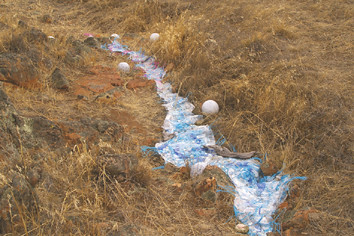l. Palimpsest 2009
Palimpsest: writing material or manuscript on which the original writing has been erased and written over
PALMER PROJECT – ART AND ECOLOGY
A D A P T A T I O N
A one day event on Sunday 5th April 2009
Part of Murray Darling Palimpsest #7
An Australian contemporary visual arts event remarkable for its locations in distinctly regional places rather than capital cities and significant for its direct engagement with issues of environmental and social sustainability.
See: www.artsmildura.com.au/palimpsest/
Artists contributing too the Palmer Palimpsest 2009

Sandy Elverd, Still life. Found objects, sand, glue, dimensions variable
Artist Statement: Still life speaks of past lives stilled, of drought, water restrictions and the changes in land use over time. The stained Australian landscape, dying, is evidence of the current major ecological impacts which have resulted from our approach to colonising this land.

John Hayward, Memory Pointer: Changing Times and Climes, Sheet steel and timber. 180 x 120 x 50 cm
Artist Statement: There was a time when the Australian landscape was a seascape. There was also a time, before the barrages were built at Goolwa, when sharks found their way up the Murray River. This one must be lost or at least a lost memory.


Greg Johns, River Boat – House Boat, redgum, corten steel, stone
Artist Statement: The “River Boat”, made from Redgum, is placed on top of the “high country” at Palmer, it points to the bend in the River Murray in the distance. The form, carving, burning suggest a connection with the river. The “House Boat” is placed up in one of the old pear trees at Palmer, stranded, high and dry. Next to the old pear trees are the minimal remaining ruins of some old European housing.

Sue Kneebone, H E A R I N G loss, furniture, copper wire, sound, dimensions variable.
Artist Statement: H E A R I N G loss is a sound installation reviving the arcane language of Morse code from 19th Century telegrams which relayed urgent cries for help for those expunged from their lands due to the maladaptive effects of agriculture and pastoralism. Non-indigenous attitudes to the environment have transformed the land into an ‘ecological disaster zone, they replaced the land’s ancient soundscape with silences and voices and meanings of their own…’ Jane Belfrage, “The Great Australian Silence: Inside Acoustic Space’ Australian Sound Design Project (1994)

Gavin Malone, A Tale of Two Hemispheres – A dumb rate of Adaptation, limestone, river red gum burl, sheoak
Artist Statement: Adumbrate: to outline, to give a faint indication of, to foreshadow. I look forward to the day when we have red gum, limestone and sheoak for brains, when we overcome our cultural mal-adaptation and adapt our thinking and cultural practices, from agriculture to high culture, to be of this place.

Ray Meandering, Frog’s Spawn, plastic bags, baling twine, lamp fittings, glass, threads. 675 x 45 cm. See also raymeandering Youtube
Artist Statement: Frogs have two life stages amphi and bios, meaning ‘two lives’. Frog’s Spawn has metamorphosed the human connection of our ambiguous living and 1 million square kilometres of an in-land ecosystem, the Murray Darling Basin. The process of this work is an evolving, ever changing mass, growing and reforming with new ideas and materials. Like disruptive systems in nature, Frog’s S’pawn comes from human movement on and across the Murray as we “Pawn the Food Bowl of Australia”. Adaptation affects all aspects of life when a habitat changes. The global frog populations are becoming smaller as human greed grows bigger, raping the natural ecology of Australian landscapes.

Tis Milner-Nichols, Child, cast bronze. 55 x 40 x 27 cm
Artist Statement: Alone in the landscape provokes consideration and challenges our perception. What experiences and heritage are been afforded future generations? Is the child lost in harsh, barren countryside or a reminder of the magic of congenial play absorbed in the moment regardless of surroundings?

Ann Newmarch, Car Debris… as the Serpent Struggles still, hubcaps and painted timber, 600 cm long
Artist Statement
The Rainbow Serpent, in Aboriginal Mythology, created the landforms with its movement across this vast country, now traversed by roads and highways that are made for convenience, rather than sympathy for the landscape. This work relates to an earlier series ‘as the Serpent Struggles’ and arose from my collection of discarded hubcaps. I began to see them as scales, hence using them ironically (sic) or plastically, (ha) as snake scales…and related to the serpent.

Astra Parker, Charred Pod Forms, plaster, three pieces each approx. 85 x 25 x 18 cm
Artist Statement: All elements of nature are constantly adapting to the place they inhabit. The need to adapt comes as a result of changes in environment brought about by natural forces and by the impact of humanity. Whatever does not adapt perishes. The charred seedpod is an example of nature’s ability to surmount adversity. It releases new seed thereby continuing the cycle of life in all its stages: birth, growth, death, decay and regeneration.
 Vic Waclawik, Steel Wool, Wire mesh 90 x 60 x30 cm
Vic Waclawik, Steel Wool, Wire mesh 90 x 60 x30 cm
Artist Statement
The Australian landscape has been bruised and battered for over 200 years by the hard, sharp hooves of introduced stock animals. Animals such as sheep are not suited to the land and are as unadapted to it as if they were made from steel.
